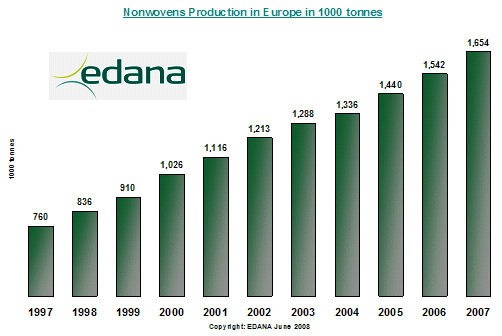EDANA’s just released Nonwovens Statistics for 2007 reveal that production in Europe is still growing. The 1,654,200 tonnes produced in 2007 represent a 7.3% growth compared to 2006.
EDANA has also, jointly with INDA, announced that they will publish their triennial statistical and forecast report, Worldwide Outlook 2007-2012 by the end of July. Last published in 2005, this edition will feature a new section on nonwovens’ international trade flow.
According to figures released by EDANA, the international association serving the nonwovens and related products industries, production of nonwovens in Greater Europe (Western, Central and Eastern Europe, Turkey and CIS) grew by around 7.3% in 2007 to reach 1,654,200 tonnes. This compares with 1,541,600 tonnes in 2006 when the annual growth was 7.1%.

According to an estimate, based on the same sample of companies in 2006 and 2007, the average price of nonwovens appears to have decreased by almost 2% from €3.34 to €3.27 per kg. The total turnover of the European nonwovens industry is estimated at around €5,410 million.
Diverging trends are affecting the various bonding processes of drylaid nonwovens. Jacques Prigneaux, EDANA’s Business Analyst revealed: “Growth in the needling process has still been substantial this year at 10% but it is actually the hydroentanglement process that has recorded the highest apparent growth at 10.1%.” Spunmelt nonwovens, on the other hand, again witnessed growth of nearly 9% in 2007. Airlaid production, compared to figures of 2006, has recorded an impressive growth of 10.4%, mostly due to increase in deliveries to the hygiene sector.
The main end-use for nonwovens remains the hygiene market with a 33% share of deliveries, amounting to 538,100 tonnes. This has grown by 7.4% in 2007.
The most significant growth areas for nonwovens in 2007 were civil engineering (14.8%) and building/roofing (11%), followed by all wipes together (10.7%), a diversity which perfectly illustrates the on-going growth and innovative uses – both industrial and daily-life – of nonwovens even in a maturing market like Europe.
Polypropylene, either in fibre or granule form, continues to be the most important polymer used in the European nonwovens industry accounting for 812,863 tonnes, 47.7% of the total fibre and polymer chip consumption, but polyester has retained the highest growth (10.4%).
In 2007 the positive EU balance of exports and imports of nonwovens roll goods has increased. EU27 Member States altogether exported 246,893 tonnes of nonwovens (compared to 216,599 tonnes in 2006) at a value of almost €1,017 million, which represents a 14% increase in volume and 8.4% in value compared to the previous year. Moreover this positive trade balance in nonwovens increased by more 20% in 2007, at almost € 0.5 billion, while the trade deficit of the EU textile sector increased by nearly 33%, at € 2.8 billion.
Although detailed data of the “2007 European Nonwovens Production and Deliveries” is only available to EDANA member companies, a summary will be available shortly on the EDANA website, www.edana.org.
Worldwide Nonwovens Outlook 2007-2012 released by the end of July
EDANA and INDA, the US association of the nonwovens fabrics industry, will publish their triennial statistical and forecast report, Worldwide Outlook 2007-2012 by the end of July.
Topics covered include:
* the worldwide regional nonwoven markets
* the production by web forming process
* the leading end-market consumption by major region
* the staple fibre and resin consumption
* international trade flow of nonwovens (for the first time)
The Worldwide Outlook can be purchased from EDANA for €2,500. Special discounted rates apply for EDANA members; please contact Eva Fabbri for details.
Jacques Prigneaux is a business analyst for EDANA. He can be reached at +32 2 734 93 10, fax +32 2 733 35 18, email jacques.prigneaux@edana.org, website www.edana.org.











